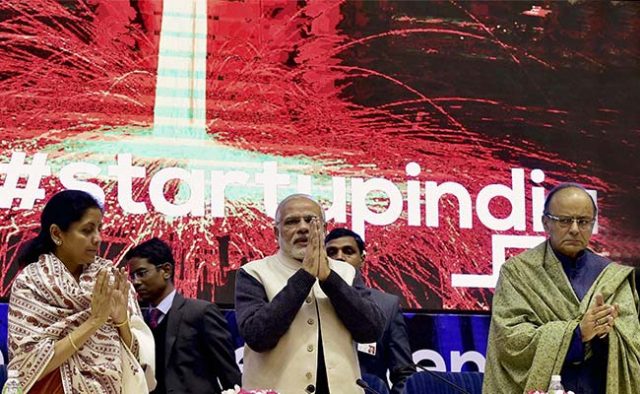By Khushi Poddar
“Bangalore based fintech start up Finomena shuts its shop after it fails to raise series-A funding.”
This is the recital of just one of the 11 major startup shutdowns that happened in 2017. Despite India’s entrepreneurial strength, 90% of Indian start-ups fail within five years of its inception. Reasons, one may ask?

The start-up India campaign initiated by the Indian Government is still trying hard to get its nuts and bolts in place. The big chest worth of INR 10,000 crores stole the headlines and highlights of the previous year. According to it, SIDBI was to invest in the venture capitalists, which were to in turn invest in start-ups. Not a single rupee got disbursed. The blemish caught later on was that the bank puts in only 15% of the total corpus, while the VCs have to fetch in the remaining 85%.
By tweaking the definition of start-ups to a venture of 5-7 years, with an annual turnover not exceeding INR 25 crores in any preceding financial year, the government has linked employment generation and wealth creation plans to it. Instead of this acting as a boon, it has become a hindrance for start-ups as most entrepreneurs limit cost of resources by reducing manpower. The strict definition of Start-ups by the Indian government recognised only 502 out of 1368 applications as start-ups. An even smaller number- 111, was considered for tax benefits.
Moreover, tax benefits are really illogical because they specifically assume that the start-ups make profit in their first three years. Statistics, however, point out that only a small percentage of start-ups succeed at all, let alone make profits so early.

Also as a result of the government of India introducing policies to support FDI, several huge MNCs having large amounts of capital come and operate in India, snatching the opportunity from small Indian entrepreneurs.
All these operational issues only provide a hostile business environment, instead of an enabling one.
Let’s relate now to the well-known cash-crunch. Finance, to young start-ups comes mainly through VCs and angel investors. Many companies who have what it takes to make it work fail to get funding through VCs because the investment process is a complicated one and potential companies are vetted out thoroughly.
Another angle of discouragement is that the average VC stake is around 35%. When in the initial tender period of business, start-ups struggle to simply survive, providing such a high stake is irrational and completely out of question. Crowdfunding (providing finance to start-ups through audience engagement), is a blooming concept in the foreign countries but has not set sail yet in India.
Also, a study suggests that if a VC invests Rs. 100 in start-ups, then in a couple of years, the investor gets Rs. 700 in Israel, Rs. 500 in the U.S., but only Rs. 110 in India. Taking into account service companies and rates of inflation, there results a net loss to the investor in India. Why, then, would he want to invest in Indian start-ups.
Read More: Is the Startup Investing Culture All A Big Ponzi Scheme? (Video)
An in-built remote to regulate the television on mobile phone, and an online portal to sell groceries might seem like appealing start-up ideas but they have a huge probability of not working out. The problem with the first one is, most of the smartphones nowadays have a low battery life and people do not mind having an extra remote for the television.
In case of the second, most middle-class people feel the need to touch and feel the vegetables before buying it. Here comes in another reason why Indian start-ups do not work out- simply because they do not concentrate on what the customers need. Instead of fulfilling the existing needs of consumers and channelizing their needs towards something new, we are much more concerned about coming up with out of the box ideas. This dissonance in perceptions and actual requirements is a big reason for start-ups not getting enough customers. Finding water for the thirsty makes much more sense than finding a thirsty person for our newly flavoured juice.

We mustn’t forget the big role that society has played in creating such an unfavourable climate for start-ups in India. Failure, in India, is looked upon as the end of one’s lifetime career rather than simply a bump in the road to success. The irrational fear of an unconventional path and the inability to think beyond the traditional framework of success kept Kailash Nadh from pushing a globally successful product (boastMachine, one of the earliest blogging engines) to its last mile.
Another huge deterrent to Indian start-ups is also the troubles faced in licensing or obtaining a patent. The process of obtaining a countrywide patent in India stretches over 3-4 years. By that time period, the idea that the entrepreneur has come up with might become obsolete and the investors might withdraw their money by that time. To obtain the patent faster, a bribe may be given, thus bringing corruption too into the loop.
Shareholder’s activism is not a very well recognised term in India, and thus many start-ups fail as they do not realise that the CEO is not the alma-mater of the company. This is what happened in Housing.com which eventually had to shut down some areas and lay off employees.
Since 2015, 1503 start-ups have closed in India. India is thus facing a sort of start-up bubble, popping of which has become absolutely necessary.
Image Credits: Google Images
Other Recommendations:
http://edtimes.in/2017/11/can-we-trust-indian-startups-anymore-with-our-salaries/


































Over 50% of startups fail in the US after four years. Did you notice why startups fail? We analyze the main factors for companies’ fiasco. Keep reading and check out the 11 main reasons for the startup’s failure.